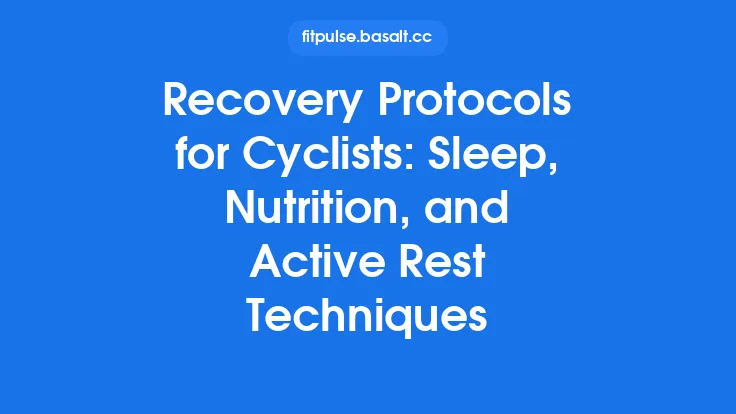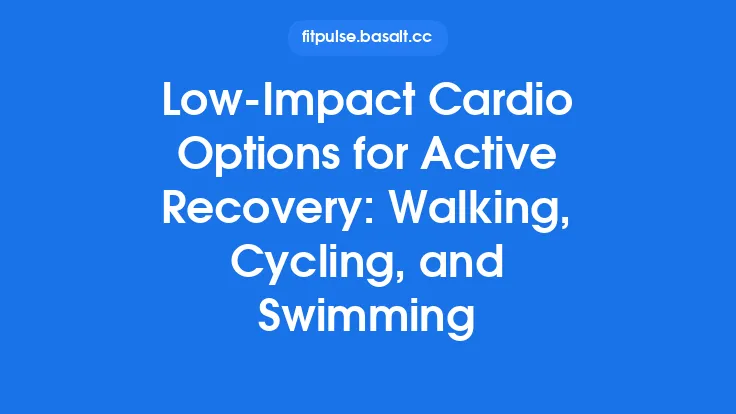Micronutrients—vitamins and minerals—are the often‑overlooked foundation of an athlete’s nutritional toolbox. While macronutrients provide the fuel and building blocks for training, micronutrients act as the catalysts that enable energy production, tissue repair, immune defense, and the myriad biochemical pathways that keep the body running efficiently. For active individuals, even subtle shortfalls can translate into reduced performance, slower recovery, and an elevated risk of injury or illness. Understanding which micronutrients are most critical, how training influences their requirements, and how to secure them through diet (and, when necessary, supplementation) is essential for anyone seeking to optimize health and athletic potential over the long term.
Why Micronutrients Matter for Active Lifestyles
- Catalytic Role in Metabolism
Enzymes that drive glycolysis, β‑oxidation, the citric‑acid cycle, and oxidative phosphorylation are dependent on specific vitamins (e.g., B‑complex) and minerals (e.g., magnesium, iron). Without adequate co‑factors, the efficiency of ATP generation declines, leading to earlier onset of fatigue.
- Support of Musculoskeletal Integrity
Calcium, vitamin D, magnesium, and phosphorus are integral to bone mineralization and remodeling. Weight‑bearing and high‑impact activities place repeated stress on the skeletal system; sufficient micronutrient supply helps maintain bone density and reduces fracture risk.
- Antioxidant Defense and Inflammation Modulation
Exercise induces reactive oxygen species (ROS) as a by‑product of increased oxygen consumption. Vitamins C and E, along with minerals such as selenium and zinc, function as antioxidants that neutralize excess ROS, limiting oxidative damage and supporting recovery.
- Immune Function
Intense training can transiently suppress immune competence. Micronutrients like vitamin A, vitamin D, zinc, and iron are pivotal for the proliferation and activity of immune cells, helping athletes stay healthy during training blocks and competition periods.
- Hormonal Balance and Adaptation
Vitamin D and zinc influence testosterone and cortisol pathways, while B‑vitamins are essential for the synthesis of neurotransmitters that affect mood and motivation. Proper micronutrient status can therefore affect both physiological adaptation and psychological readiness.
Key Vitamins for Exercise Performance
| Vitamin | Primary Physiological Functions | Exercise‑Related Relevance | Food Sources |
|---|---|---|---|
| Vitamin A (Retinol & β‑carotene) | Vision, immune cell differentiation, protein synthesis | Supports mucosal immunity; aids in tissue repair | Liver, sweet potatoes, carrots, dark leafy greens |
| Vitamin B1 (Thiamine) | Co‑factor for pyruvate dehydrogenase; carbohydrate metabolism | Enhances glucose utilization during high‑intensity work | Whole grains, pork, legumes, nuts |
| Vitamin B2 (Riboflavin) | Electron transport chain, fatty‑acid oxidation | Facilitates aerobic energy production | Dairy, eggs, almonds, fortified cereals |
| Vitamin B3 (Niacin) | NAD⁺/NADP⁺ synthesis, glycolysis, TCA cycle | Critical for ATP generation in endurance activities | Poultry, fish, peanuts, mushrooms |
| Vitamin B6 (Pyridoxine) | Amino‑acid transamination, glycogenolysis | Supports protein turnover and glycogen replenishment | Chickpeas, bananas, salmon, potatoes |
| Vitamin B9 (Folate) | DNA synthesis, red‑blood‑cell formation | Important for recovery and oxygen transport | Leafy greens, legumes, citrus fruits |
| Vitamin B12 (Cobalamin) | Methylmalonyl‑CoA mutase, myelin synthesis | Prevents anemia, maintains neuromuscular function | Meat, dairy, fortified plant milks |
| Vitamin C (Ascorbic Acid) | Collagen synthesis, antioxidant, iron absorption | Enhances connective‑tissue repair; mitigates oxidative stress | Citrus, strawberries, bell peppers, kiwi |
| Vitamin D (Calciferol) | Calcium absorption, bone remodeling, immune modulation | Improves muscle function, reduces injury risk | Sunlight exposure, fatty fish, fortified dairy |
| Vitamin E (Tocopherol) | Lipid‑soluble antioxidant, membrane stability | Protects cell membranes from ROS generated during prolonged exercise | Nuts, seeds, spinach, wheat germ |
| Vitamin K | γ‑carboxylation of clotting factors, bone protein osteocalcin | Contributes to bone health and vascular health | Kale, broccoli, fermented soy (natto) |
Practical note: Water‑soluble B‑vitamins are not stored in large quantities; regular intake through varied diet is essential, especially for athletes with high turnover rates.
Essential Minerals Supporting Training Adaptations
| Mineral | Core Biological Role | Exercise‑Specific Impact | Food Sources |
|---|---|---|---|
| Calcium | Bone mineral matrix, muscle contraction (via Ca²⁺ signaling) | Maintains skeletal strength; supports neuromuscular transmission | Dairy, fortified plant milks, sardines, tofu |
| Iron | Component of hemoglobin, myoglobin, and mitochondrial enzymes | Critical for oxygen transport and aerobic capacity; deficiency impairs endurance | Red meat, poultry, lentils, spinach (enhanced with vitamin C) |
| Magnesium | Cofactor for >300 enzymatic reactions, ATP stability, muscle relaxation | Influences energy production, reduces cramping, aids recovery | Nuts, seeds, whole grains, leafy greens |
| Zinc | DNA synthesis, immune cell function, testosterone production | Supports tissue repair, hormone balance, and immune resilience | Oysters, beef, pumpkin seeds, chickpeas |
| Selenium | Selenoproteins (e.g., glutathione peroxidase) for antioxidant defense | Mitigates oxidative damage from high‑intensity bouts | Brazil nuts, tuna, eggs |
| Phosphorus | Component of ATP, phospholipids, bone mineral | Supplies immediate energy for muscular work | Dairy, meat, beans, nuts |
| Copper | Iron metabolism, connective‑tissue cross‑linking, antioxidant enzymes | Facilitates iron utilization and collagen formation | Shellfish, nuts, whole grains |
| Manganese | Enzyme cofactor for carbohydrate and lipid metabolism | Supports energy production and bone health | Whole grains, nuts, tea |
| Chromium | Enhances insulin signaling | May aid glucose uptake during training (evidence modest) | Broccoli, whole grains, nuts |
Key insight: While many minerals are abundant in a balanced diet, athletes—particularly endurance runners, female athletes, and those on restrictive diets—may experience increased losses through sweat, urine, or gastrointestinal bleeding, necessitating closer monitoring.
Increased Micronutrient Demands in Different Types of Exercise
| Exercise Modality | Micronutrient(s) with Elevated Requirement | Reason for Increased Need |
|---|---|---|
| Endurance (e.g., marathon, cycling) | Iron, B‑vitamins, magnesium, zinc, vitamin C | Prolonged oxidative metabolism, hemolysis, sweat losses, and higher turnover of energy‑producing enzymes |
| High‑Intensity Interval Training (HIIT) | Vitamin C, vitamin E, selenium, B‑complex | Acute ROS surge, rapid ATP turnover, and heightened catecholamine synthesis |
| Strength/Power (e.g., weightlifting) | Vitamin D, calcium, zinc, magnesium | Bone remodeling, muscle protein synthesis, and neuromuscular contraction |
| Team Sports (e.g., soccer, basketball) | Vitamin A, vitamin D, iron, potassium | Repeated sprint‑stop patterns, exposure to outdoor sunlight, and mixed aerobic‑anaerobic demands |
| Cold‑Weather Training | Vitamin D, iron, zinc | Reduced sunlight synthesis of vitamin D; increased respiratory losses of iron; immune challenges |
Understanding these modality‑specific patterns helps athletes prioritize certain foods or consider targeted supplementation during training cycles.
Assessing Micronutrient Status: Tools and Strategies
- Dietary Analysis
- Food Frequency Questionnaires (FFQs) and 7‑day weighed food records provide a macro‑level view of intake. Software that includes micronutrient databases (e.g., USDA FoodData Central) can flag potential shortfalls.
- Biochemical Markers
- Serum Ferritin (iron stores)
- Serum 25‑hydroxyvitamin D (vitamin D status)
- Plasma Zinc (zinc status)
- Red Blood Cell (RBC) Folate (folate status)
- Serum Magnesium (though intracellular magnesium may be more informative)
Interpretation should consider acute-phase responses; for example, ferritin rises during inflammation, potentially masking iron deficiency.
- Functional Tests
- Bone Mineral Density (DEXA) for calcium/vitamin D adequacy.
- Exercise Performance Metrics (e.g., VO₂max, time‑to‑exhaustion) can indirectly reflect micronutrient sufficiency when correlated with dietary data.
- Clinical Signs
- Persistent fatigue, hair loss, or impaired wound healing may hint at deficiencies, prompting targeted testing.
A systematic approach—combining dietary review, laboratory assessment, and functional outcomes—offers the most reliable picture of an athlete’s micronutrient health.
Optimizing Food Choices for Adequate Micronutrient Intake
- Emphasize Whole, Minimally Processed Foods
Whole grains, legumes, nuts, seeds, fruits, and vegetables retain the bulk of their micronutrient content compared with refined counterparts.
- Pair Iron‑Rich Foods with Vitamin C
The ascorbic acid–mediated reduction of ferric (Fe³⁺) to ferrous (Fe²⁺) dramatically improves non‑heme iron absorption. A simple salad with bell peppers alongside a lentil stew exemplifies this synergy.
- Include Fat‑Soluble Vitamin Sources with Healthy Fats
Vitamin D, A, E, and K are better absorbed when consumed with dietary lipids. Adding avocado or olive oil to a kale salad boosts vitamin K uptake.
- Utilize Fermented Foods for Enhanced Mineral Bioavailability
Fermentation can degrade phytates, which otherwise chelate minerals like zinc and iron. Sauerkraut, kimchi, and tempeh are practical options.
- Rotate Colorful Produce
Different pigments correspond to distinct phytonutrients and associated vitamins (e.g., β‑carotene in orange carrots, lutein in dark greens). A varied “rainbow” plate ensures a broad spectrum of micronutrients.
- Mind Cooking Methods
- Steaming preserves water‑soluble vitamins better than boiling.
- Short, high‑heat methods (e.g., stir‑frying) retain both vitamins and minerals while enhancing flavor.
- Avoid excessive oil when cooking vitamin‑E‑rich foods, as oxidation can degrade the vitamin.
Practical Strategies to Enhance Absorption and Utilization
- Timing of Micronutrient‑Rich Meals
While the article avoids “nutrient timing” per se, spacing meals to avoid large gaps can prevent prolonged periods of low plasma nutrient concentrations, especially for water‑soluble vitamins.
- Addressing Antinutrients
- Phytates (found in whole grains and legumes) bind zinc, iron, and calcium. Soaking, sprouting, or fermenting can reduce phytate content.
- Oxalates (in spinach, beet greens) impede calcium absorption; pairing calcium‑rich foods with low‑oxalate sources can mitigate this.
- Hydration and Mineral Balance
Adequate fluid intake supports renal clearance of excess minerals and prevents concentration‑dependent losses. While not a focus on electrolyte balance, maintaining normal hydration is a prerequisite for optimal mineral handling.
- Gut Health
A healthy microbiome can synthesize certain B‑vitamins (e.g., B12, folate) and improve mineral absorption. Probiotic‑rich foods (yogurt, kefir) and prebiotic fibers (inulin, resistant starch) support this ecosystem.
- Avoiding Excessive Alcohol and Caffeine
Both can increase urinary excretion of magnesium, zinc, and B‑vitamins, potentially creating hidden deficits in athletes who rely on these stimulants.
Potential Risks of Deficiency and Excess
| Micronutrient | Deficiency Manifestations | Toxicity Risks (if Excessive) |
|---|---|---|
| Vitamin D | Osteomalacia, increased fracture risk, impaired muscle function | Hypercalcemia, nephrolithiasis |
| Iron | Anemia, reduced VO₂max, fatigue | Hemochromatosis (organ damage), oxidative stress |
| Calcium | Osteopenia, muscle cramps | Vascular calcification, kidney stones |
| Magnesium | Muscle twitches, arrhythmias, impaired recovery | Diarrhea, hypotension (rare with supplements) |
| Zinc | Impaired immunity, delayed wound healing | Copper deficiency, dyslipidemia |
| Vitamin C | Scurvy (rare), impaired collagen synthesis | Gastrointestinal upset, kidney stones (high doses) |
| Vitamin E | Neuromuscular problems, oxidative damage | Bleeding risk (interferes with vitamin K) |
| Selenium | Cardiomyopathy, compromised antioxidant defense | Selenosis (hair loss, nail brittleness) |
Athletes should aim for the Recommended Dietary Allowance (RDA) or Adequate Intake (AI) for each micronutrient, adjusting upward only under professional guidance after documented need.
Special Considerations for Specific Populations
- Female Athletes
Menstrual blood loss can increase iron requirements (up to 1.5 × RDA). Incorporating heme iron sources and vitamin C‑rich foods is especially important. Additionally, calcium and vitamin D are critical for bone health, given the higher prevalence of stress fractures in women.
- Older Athletes (≥ 50 years)
Age‑related declines in gastric acid secretion reduce non‑heme iron absorption, while skin synthesis of vitamin D diminishes. A diet rich in fortified foods and possibly low‑dose supplementation may be warranted.
- Vegetarians and Vegans
Plant‑based diets can be low in vitamin B12, iron (non‑heme), zinc, calcium, and omega‑3 fatty acids. Regular B12 supplementation, strategic food pairings (e.g., legumes with citrus), and fortified plant milks help bridge gaps.
- High‑Altitude or Cold‑Climates Training
Increased respiratory water loss can elevate zinc and copper excretion. Vitamin D synthesis may be limited by reduced sunlight exposure, necessitating dietary or supplemental sources.
Putting It All Together: A Sample Micronutrient‑Focused Meal Plan
| Meal | Components (≈ 500 kcal) | Key Micronutrients |
|---|---|---|
| Breakfast | Greek yogurt (200 g) + mixed berries + 2 tbsp chia seeds + whole‑grain toast with almond butter | Calcium, vitamin D, vitamin C, magnesium, zinc |
| Mid‑Morning Snack | Hard‑boiled egg + orange slices | Vitamin A, B‑vitamins, vitamin C, selenium |
| Lunch | Quinoa salad with grilled salmon, spinach, roasted red peppers, pumpkin seeds, olive‑oil vinaigrette | Vitamin D, omega‑3, iron (heme), magnesium, zinc, vitamin E |
| Afternoon Snack | Trail mix (walnuts, dried apricots, Brazil nuts) | Selenium, magnesium, vitamin E, iron (non‑heme) |
| Dinner | Stir‑fried tofu, broccoli, carrots, bell peppers, brown rice, ginger‑garlic sauce | Calcium, vitamin K, vitamin C, B‑vitamins, iron (non‑heme) |
| Evening | Warm milk (or fortified soy milk) with a dash of cinnamon | Calcium, vitamin D, vitamin B12 (if fortified) |
Note: Portion sizes can be adjusted to meet individual energy needs. The plan intentionally mixes heme and non‑heme iron sources, pairs vitamin C‑rich produce with iron‑containing foods, and includes healthy fats to aid fat‑soluble vitamin absorption.
Final Thoughts
Micronutrients may not dominate the conversation in the gym, but they are the silent architects of every physiological process that underlies training success. For active individuals, the interplay between exercise stressors and micronutrient status is dynamic: training can increase needs, while dietary choices dictate availability. By grounding nutrition strategies in a solid understanding of vitamin and mineral functions, recognizing sport‑specific demands, and employing practical dietary tactics, athletes can safeguard their health, enhance performance, and sustain long‑term progress. Regular assessment—through both dietary tracking and targeted laboratory testing—ensures that any gaps are identified early, allowing for timely dietary adjustments or evidence‑based supplementation. In the ever‑evolving field of exercise nutrition science, the fundamentals of micronutrient adequacy remain evergreen, forming a timeless pillar of athletic excellence.




